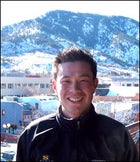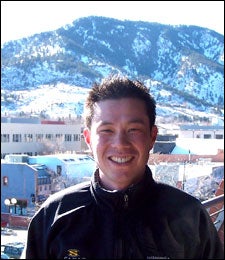Lance Armstrong’s seventh and final triumphant parade down Paris’s Champs-Élysées last July 24 marked the end of one competition and the beginning of a new one: the race to see which American pro cyclist will inherit the Texan’s mantle. Native Pennsylvanian and Mennonite-turned-badass Floyd Landis bolstered his claim to the inheritance by racking up some imposing early-season results this spring, including two individual time-trial stage wins and first overall at three prestigious weeklong stage races: the Tour of California, Paris-Nice, and the Tour de Georgia.
Allen Lim
 Allen Lim in his hometown of Boulder, Colorado
Allen Lim in his hometown of Boulder, ColoradoCredit part of Landis’s success to Allen Lim, a 33-year-old physiology-and-biomechanics Ph.D. from the University of Colorado at Boulder who met the cyclist at a training camp in January 2005 and immediately took on the role of number cruncher on his training team. “Floyd impressed me that week because he didn’t have the pretense of so many athletes out there,” says Lim, whose work with Landis and U.S. pro team TIAA-CREF is fast earning him a reputation among the cycling elite. “I became really invested in helping him succeed.”
AARON GULLEY sat down with Lim to ask him about his power-meter-based training methodologies—and why that research might just put Floyd Landis in yellow at the finish of the 2006 Tour de France.
���ϳԹ���: Floyd has had an impressive spring. Have you been surprised by how successful he’s been?
Lim : Not at all. What people don’t realize is that these results are a product of the intelligent decisions Floyd made last season and all the hard work he’s done—last year, in the off-season, and over the last decade. He pulled out of last year’s Vuelta [a España] before burying himself, which gave him more time to recover in the fall, allowed him to have a productive winter, and has brought him some good results this spring.
I’m sure you hear the inevitable grumble that Floyd is peaking too early. How do you respond?
That’s ridiculous. People haven’t seen Floyd at even 90 percent yet this year. Based on how he feels and the numbers he produces in training, Floyd is going to shock everyone when he hits his peak. People have no idea what’s coming.
Do you think it’s partly a mental thing, a question of momentum—once you start winning, you’re more likely to win?
Definitely. Floyd has so much more confidence this year. He’s a different rider. Like on Brasstown Bald [the decisive climbing stage in the Tour de Georgia], you could just see it in his eyes: There was no way that Tom [Danielson] was going to drop him. Floyd had just decided in his mind that he wouldn’t let it happen. And once you believe, once you learn to win, you become really hard to beat.
How are you training Floyd?
My relationship with Floyd is that of a resource, a training adviser. If he has a question about some aspect of his training or performance, I’ll do the research and hopefully give him a practical answer. My primary role right now is to help monitor his pre-Tour buildup and his performance at the Tour. A lot of what I do is document and evaluate his training and racing numbers. Last year, he used a CycleOps PowerTap every time he was on the bike, so we have a complete numeric record of everything he did. That creates an advantage for the future, because we can look at those results, weed out the static, and give him feedback about his specific strengths and weaknesses, which helps him optimize his training.
How do you go about that?
We evaluated specific stages from the Tour de France last year, like Stage 10, where Floyd got dropped by Lance. Since Floyd was riding with the power meter, we know his exact output. And using Lance’s finish time, we can quantify exactly how much more power Floyd would have needed to stay with Lance. That differential gives Floyd a reference point and specific power goals in his training. As an example, in some of the Tour stages, like Stage 10, Floyd needed to be able to generate more top-end, anaerobic power. Knowing that, he can create workouts to mimic that kind of output.
On paper, how does Floyd compare with Lance?
Last year, Lance won the Tour, and Floyd came in ninth—that’s the only paper that matters. You can only make comparisons relative to actual finishing times on specific performances. Let’s say Floyd went up a hill in 15 minutes, while Lance went up it in 14 minutes. After the race, we can watch the tape and figure out how that difference occurred by studying the moments when Lance accelerated away from Floyd and the rest of the group. If he put, say, 20 meters on the field in five seconds, then we could do the math relative to what Floyd was producing and calculate that Lance did maybe 300 more watts than Floyd during those five seconds. Last year a lot of the difference between Floyd and Lance occurred due to those top-end accelerations, so Floyd has worked on that.
Was that ability specific to Lance?
That top-end power? Based on how he won the last seven Tours, I would say so. But Lance had it all: He was a really complete rider and a dominant one. If you look at the final time trial of the Tour last year [Stage 20, at Saint-Etienne], Lance and Jan [Ullrich] were within a percentage of each other, and then there was a statistically significant gap (around 3 or 4 percent) to the rest of the guys in the top ten. This makes Jan a real threat at this year’s Tour: If he can put it all together like that this year, he is going to be formidable. But even Jan doesn’t seem to have Lance’s ability to accelerate. So who knows what will happen this year—it’s wide open.
What single aspect of Floyd’s new training gives him the biggest edge?
Floyd has started doing more top-end training in the anaerobic zone. He has focused on that a lot, doing five-to-ten-minute intervals on really steep stuff, the 18-percent-grade, Brasstown Bald-type climbing. And judging by his performance in Georgia, that specific training really paid off. Last year Floyd lost over a minute to Danielson on that climb; this year Tom couldn’t shake him.
Do you train athletes in breath holding?
There is some interesting scientific and anecdotal evidence about hypoxic interval training—essentially holding your breath or limiting oxygen intake while doing an all-out interval. There’s still a lot of mystery about how the body adapts. Remember, at this top level we’re often trying novel things. Some will remain theories; others might catch on as serious training technique. This type of training is definitely dangerous, and nobody should attempt it without the supervision of a coach and/or doctor.
There’s research that shows that when an athlete is up close to max, near the point when they’re about to quit, there’s a drop in cerebral blood flow. It’s like a self-preservation switch: The brain forces the body to stop working to preserve blood flow to the brain. So the idea behind breath holding is to train your body to maintain that cerebral blood flow even when you’re not getting enough oxygen. Basically, an athlete holds his breath during intervals to become accustomed to the mind-popping efforts produced while racing. For cycling, a rider would do an all-out effort between 30 seconds and two minutes, trying not to take a breath during the interval. It’s close to impossible, and it will really hurt. If the rider doesn’t pass out, crash, or kill himself, maybe the training will make him stronger.
Will Floyd use this technique?
No, probably not. When we’re training this spring in Europe, I’ll suggest it. But he’ll probably just look at me like I’m insane.
Floyd is very open about his power numbers, posting them on the Internet for anyone to see. Aren’t you worried about giving away his strengths or weaknesses?
Some people were worried that we were giving away too much, but I don’t think Floyd lost much sleep over it. The numbers are specific to Floyd and to a specific ride, including tactics, terrain, and weather. Even if [Ivan] Basso looks at these numbers and sees a supposed weakness, it doesn’t help him. What a lot of people don’t get is that it’s not always the guy who produces the most power that wins. If Floyd’s competitors are that concerned with matching Floyd’s numbers, then they’re not working on their own weaknesses. Ultimately, the performance is the definitive judge. We can study the power meter, analyze the numbers, and craft the perfect regimen, but at the end of the day the question is where and how you finish a race. Your power numbers can look great, but if you finish way back in the pack, then we haven’t done our job.
Will you be at the Tour with Floyd?
Starting in late May, I’ll be with him all the way through the end of the Tour. That’s the critical time. At the race, my specific job is to take the computers off the bicycles, download the information, and then think about it and give Floyd feedback. It’s my job to catch the subtle details of his output and give him information based on that output. During a race like the Tour, we mainly just sit around and talk, but we’re talking about one thing: how to win the bike race. There’s an intangible side, too. Trying to achieve something on that level—like winning the Tour—is a lonely and tough experience, so having people around for support and motivation is important.
Any highlights from the races you’ve attended?
The night before Floyd finished the Tour of California, I went out with him and Dave Zabriskie [Landis’s roommate, who rides for CSC] to the In-N-Out Burger right near LAX. It was so funny to be sitting there eating burgers and drinking milkshakes with these two skinny, scrawny dudes who were number one and two in one of the biggest bike races in America. Floyd seemed just as stoked to be eating that burger as he was to be winning the Tour of California. And yet that afternoon, he had been this vicious competitor, intent on doing anything necessary to win that race.
What motivates Floyd
I think Floyd is like anyone else: He wants to do his best, wants to quiet the critics. Most important, he just wants to take care of his family and friends. Also, like most bike racers, he’s a survivor. I think that’s why he’s so close to Dave Zabriskie—they both have hard backgrounds, and they’re both left of center. Floyd was one of those guys who didn’t quite fit in, like Napoleon Dynamite up there on stage dancing to hip-hop. That’s funny: Floyd, Napoleon Dynamite-turned-bike racer.
Do you think Floyd will win the Tour de France this year?
Absolutely. There’s nothing else to believe.


